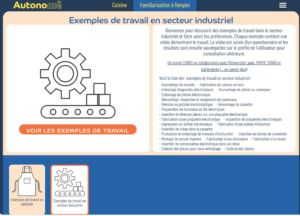Context : Labor shortages are a problem affecting all employment sectors, and the manufacturing industry is no exception. As a result, the industry is more open to recruiting people with disabilities, such as autism spectrum disorders (ASD), craniocerebral disorders (CCD) or intellectual disabilities (ID). To develop the skills of these people and enhance their employability, the Pre Vincent research team works with industrial partners to demonstrate the work carried out in the company and support familiarization with these tasks.
Objective 1 : To film employees to develop familiarization videos about working in the electronics sector for future employees of inclusive companies.
Method : A research and development specification was used to design the instructional videos.
Data collection: An occupational therapy student and a Cirris research professional visited two industrial production companies, Festo Didactic and Gentec, located in the Quebec City area. A total of 18 employees from both companies were filmed on site.
Video editing : Educational videos lasting 3 to 8 minutes were developed. In each video, concrete text read aloud and written in black and white on a slide was inserted to reinforce understanding of the task steps observed. Attention is also drawn to the sensory stimuli present in each of the work tasks, as well as the mental functions primarily used, with the aim of informing the clienteles of the aspects they might be confronted with in this type of task.
Post-supervision questions : Four to six questions were inserted to 1) probe the person’s interest in learning to perform this type of work task, 2) probe the level of discomfort with various aspects associated with performing the task, and 3) verify understanding of the task and the safety elements essential for proper operation. To write the text, the occupational therapy student used literacy concerning vocabulary related to the microelectronics sector. She also considered the learning characteristics of people with autism spectrum disorder, mild intellectual disability and moderate to severe traumatic brain injury.
Results : 24 examples of industrial work familiarization are available in :
- Material handling (4 videos)
- Carpentry (2 videos)
- Machine operation and sub-assembly (15 videos)
- Industrial painting (1 video)
- Placement of parts in warehouse with work orders (2 videos)
Distribution : To use the educational videos, click on the link below to discover 24 examples of work in the industrial sector and express your preferences for each task. The results are then saved on the user’s profile for future reference. We encourage the use of the application by high school practitioners, placement and manpower services and rehabilitation center practitioners. This will help young people with neuro-atypia to become familiar with different tasks in the manufacturing industry, so that they can better choose what appeals to them.
To access the website (in French*): Autonome Kitchen – Cuisine (app-autonome.education)
*Please note that to access the Familiarisation à l’emploi section you must be on the French site of the application. Here’s how to change the language if you access the English version of the app.
- Create your account
- Click on the familiarisation à l’emploi tab
- Choose the video to watch on Exemples de travail en secteur industriel
For access to videos only (e.g. assembling a resistor, collecting parts in the store, making an electronic wafer, etc.), go to YouTube by clicking here.


